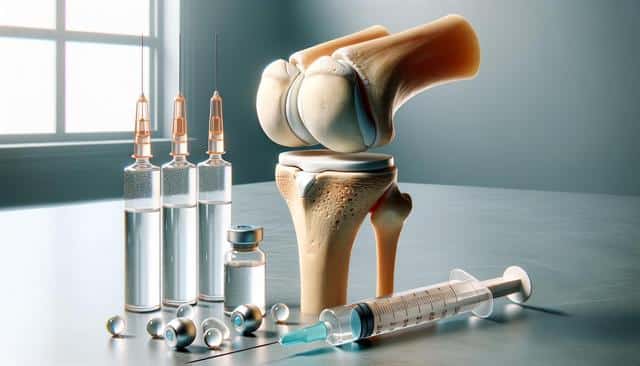
A Patient’s Guide to Knee Gel Injections: What to Know About Benefits, Risks, and Expectations
Understanding Knee Gel Injections
Knee gel injections, also known as viscosupplementation, involve the injection of a gel-like substance—typically hyaluronic acid—into the knee joint. This treatment is commonly recommended for individuals with osteoarthritis, a condition where the cartilage in the joint wears down, causing pain, stiffness, and reduced mobility. Hyaluronic acid is naturally found in joint fluid and acts as a lubricant and shock absorber. By supplementing this fluid, gel injections aim to improve joint movement and reduce pain. These injections are often considered when traditional methods like oral medication, lifestyle changes, or physical therapy haven’t provided sufficient relief.
Knee gel injections are administered in a clinical setting, usually involving one to five injections over several weeks, depending on the product and the patient’s response. The procedure itself is relatively quick and minimally invasive, often completed within minutes. While not a cure for osteoarthritis, many patients report a noticeable improvement in joint flexibility and a reduction in discomfort following the treatment cycle.
Who Might Benefit from Knee Gel Injections?
This treatment is primarily suited for individuals with mild to moderate osteoarthritis who experience chronic knee pain that interferes with daily activities. Doctors typically assess a patient’s medical history, imaging results, and response to previous treatments before recommending gel injections. It may be an appropriate option for people who:
- Have not found relief with over-the-counter pain relievers
- Prefer to delay or avoid knee replacement surgery
- Experience joint stiffness that limits mobility
- Are not good candidates for surgery due to other medical conditions
It’s important to note that knee gel injections are not suitable for everyone. Individuals with severe osteoarthritis or those with active joint infections may not benefit as much from this approach. As with any medical procedure, discussing personal health goals and concerns with a qualified healthcare provider is essential.
What to Expect During and After the Procedure
The injection process typically starts with the doctor cleaning the area and possibly using a local anesthetic to reduce discomfort. Using a fine needle, the gel is injected directly into the space within the knee joint. In some cases, excess fluid may be removed before the injection to improve efficacy. Patients are generally advised to rest the joint for a day or two after the procedure and may be asked to avoid strenuous activity temporarily.
Side effects are generally mild but can include:
- Swelling or stiffness at the injection site
- Mild pain or warmth in the knee
- Temporary inflammation
These symptoms usually resolve on their own within a few days. Most patients begin to feel some relief within a few weeks, although the full benefits may take up to two months to become noticeable. The duration of relief varies but can last several months in many cases.
Possible Risks and Considerations
While knee gel injections are considered safe for most individuals, there are potential risks and limitations to be aware of. Allergic reactions to the injection material are rare, but they can occur. Additionally, repeated injections may not be effective for everyone, and the benefits might diminish over time. Some patients also experience no improvement, which is why this treatment is often viewed as part of a broader pain management plan rather than a standalone solution.
Healthcare providers will consider the following before recommending gel injections:
- The patient’s age and activity level
- The severity of joint degradation
- Previous treatments and their outcomes
- Overall health and presence of other joint conditions
Informed decision-making is vital. Patients should discuss both the potential benefits and limitations with their medical provider and consider all available options before proceeding with treatment.
Integrating Injections into a Broader Care Plan
Knee gel injections should be viewed as one element within a comprehensive osteoarthritis management strategy. They are most effective when combined with other non-surgical treatments such as physical therapy, weight management, and low-impact exercise routines. These supportive measures can enhance the effects of the injections and contribute to longer-lasting relief.
Some tips for maximizing results include:
- Staying physically active with joint-friendly exercises like swimming or cycling
- Maintaining a healthy weight to reduce stress on the knees
- Using assistive devices when needed to decrease joint strain
- Monitoring symptoms and staying in regular contact with a healthcare provider
By adopting a holistic approach to joint care, patients may improve their overall quality of life and delay the need for more invasive treatments like surgery. Regular follow-up appointments can also help assess the ongoing effectiveness of the injections and make adjustments as needed.
Conclusion: Is This Treatment Right for You?
Knee gel injections offer a non-surgical option for managing osteoarthritis-related knee pain, especially for individuals who have not found sufficient relief through traditional methods. While not a one-size-fits-all solution, they can provide meaningful symptom improvement for suitable candidates. Understanding the procedure, setting realistic expectations, and integrating the treatment into a broader care plan are key steps in achieving the best possible outcomes.
For those exploring alternatives to surgery or long-term medication use, discussing knee gel injections with a healthcare professional may be a worthwhile next step. With careful consideration and proper guidance, this treatment could become a valuable part of your journey toward better joint health and improved mobility.


